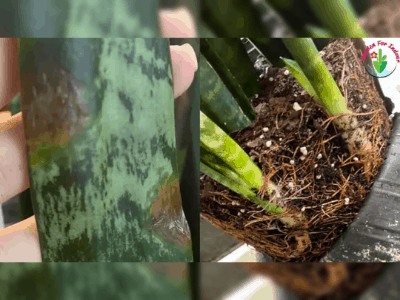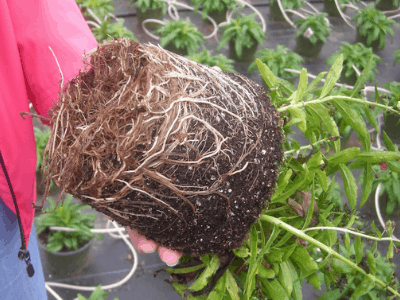
How to Identify, Fight and Prevent Root Rot
Plants afflicted with root rot will die if the condition is not treated.
Gardeners often don’t notice root rot symptoms until the damage is advanced…
…since the initial symptoms appear under the soil. When your plants start showing symptoms of root decay…
…such as yellow leaves or stunted growth, you need to act quickly to resolve the issue.
Most susceptible to root rot are plants in soils too dense for water to drain out efficiently…
…or in containers lacking sufficient drainage holes.
Plants grown in containers are mostly at risk; however, garden plants are not completely immune to root rot.
Taking steps to improve drainage and eliminate root rot can prevent most garden root rot problems.
Although it may seem like excessive water causes root rot….
…the problem actually occurs because too much water creates the perfect environment for what causes root rot: fungi.
So here are the story of Luna, about her experience encountering root rot.
Let us hear Luna’s story.
The snake plant is struggling. It hasn’t been doing too well all summer, when I first noticed the root rot.
It’s always happy around me, but it has been wilting more and more as time goes on.
I think about trimming off the leafy top to help it recover from this last bout of extreme heat…
…that we had followed by a week-long drenching rainstorm with deluges every day for seven straight days.
But there’s no way that cutting off its leaves would be enough.
The roots are completely rotted; they’re crumbling like powder under my fingers if I try to touch them…
…without gloves on in order to clean up what little mold is left around the pot.’
I search all of the method all the way through the internet.
Finally, I know hot to deal with it and now within in a week my snake plant growing stronger than ever.
No more root rot on my snake plant! I feel like an expert after encountering this problems

Although some bacteria can be good for plants, the ones that thrive in wet and soggy environments. They have the potential to create a lot of damage and issues for your Snake plant.
Arifur Rahman, Agriculturist from Bangabandhu Sheikh Mujibur Rahman Agricultural University
Here’s the thing
Identifying Root Rot
Even when rotting is occurring without any visible symptoms at first, because it starts in the roots…
….which are more often than not covered in dirt, usually hidden from view.
Occasionally, you can just take a look at the roots to see if they are white…
….and still strong but that’s not always practical or something one would think of to do.
Sometimes you have to wait for disturbing signs to let you know something is wrong…
…and then it’s too late to do anything once it gets bad enough to cause serious harm.
Root rot is identified by the appearance of soft, brown roots.
A healthy root system should be firm, white, and white-tipped. If the soil is soggy, fungal spores multiply immediately…
…which encourage the fungus to spread quickly from the roots to the rest of the plant.
A portion of the root that is healthy turns brown and mushy as the roots die from the fungus.
Consequently, the plant is unable to absorb the nutrients that it needs…
…and its diminished nutritional capacity shows up in the condition of its foliage.
During these months, growth slows down and leaf drop occurs, as well as delayed blooming.
Plants can die immediately in extreme cases when the fungus conditions are optimal for the spread of this disease.
To be sure a plant doesn’t suffer from these symptoms…
…loosen the soil around the base of the plant with a trowel or shovel and remove it from the soil.
The soil should be gently shaken off of the roots and inspected for rotting.

Next up…
Dealing with Root Rot
Once root rot is discovered, determining the plant’s chances of survival is essential.
If the roots have already become mushy, they are too late to save.
But if there are some healthy white, hard roots present, try to bring the plant back…
…to health by replanting in fresh soil with better drainage.
Plants should be prepared for replanting by thoroughly cleaning their roots with running water…
…and removing any brown, mushy roots with a sharp pair of scissors.
Work quickly to replant within a few hours. Cut the healthy root just above the damaged area.
After the roots are pruned, you should sterilize the scissors with a solution of 1 part bleach to 3 parts water…
…in order to avoid spreading fungi to other plants or soil.
A clean, fresh, well draining potting medium and fresh potted soil will be required for the snake plant to repot.
A plant will die if it has root rot, which if left untreated can also kill other plants.
A lot of times, gardeners do not recognize the symptoms for root rot until the problem has progressed significantly.
Whenever plant symptoms, such as yellow leaves or stunted growth, indicate that the plants have root rot…
…take immediate action to resolve the problem.

Last but not least
Snake plant root rot prevention
Lastly, let’s talk about prevention. Now that you know excessive watering contributes to root rot in Snake plants…
…you need to find the correct watering schedule to maintain normal moisture levels without soaking the plant all the time.
My best suggestion is to only water your Snake plant after the top few inches of soil have dried completely…
…and then do not water it again until that has happened.
It could take several weeks during the summer to more than a month during the winter.
There is no specific schedule for watering. It depends on how fast the soil dries out in your area…
…and so you don’t really have to stick to one for the sake of it.
Another tip I can offer is that if you suspect the plant has been significantly underwatered…
…do not attempt to compensate by giving the plant an excessive amount of water at one time.
This will most definitely cause issues and make root rot more likely.
You must water the soil thoroughly after it has dried out and wait until the soil dries…
…again before you begin watering again.

Sum Up
See having Snake plant is good choice for you to have! It’s cool, its famous, it’s easy to have and care!
What else do you need? In this pandemic time like this, is a good choice for you to have an new activity…
…and having snake plant is a good choice for you to have!
Conclusion
Last thing for sure. This plant need to be care carefully, remember plant need the “love” too.
Alright that’s all for today! Do you have any questions about all of this?
Or do you want to add some method that can help you for preventing root rot on your snake plant?
Let me know your recommendation from the comment below.
I hope you can now take care your snake carefully and grow it big!
Thanks for reading this article! Bye!
Manual log, data not transferred to the new server

